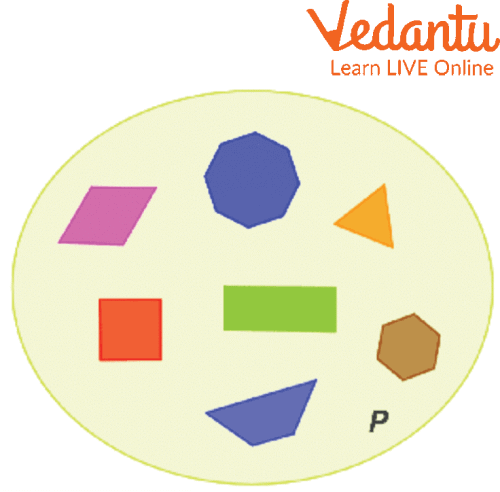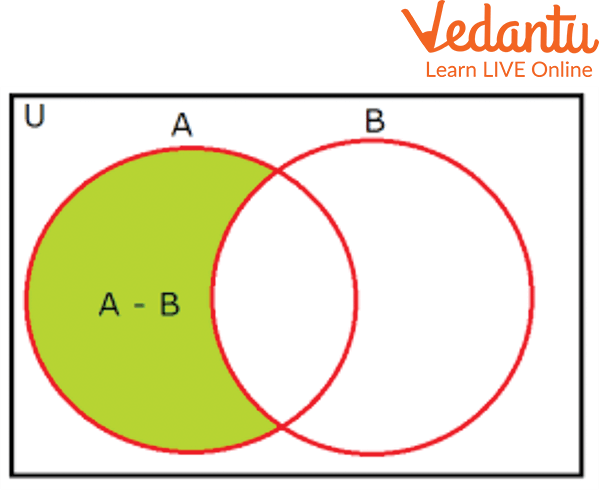




How to Solve Set Difference Problems with Easy Steps
In addition to mathematics, sets are used frequently in everyday life. The most practical example of a set is a kitchen. The kitchen is usually well organized by our mother. Kids’ school bags are another example, where you keep all your copies and books. Together make a bag, and we can call it a set. One of the most significant and fundamental sets theory operations is set difference. The difference between two sets, A and B, is another set consisting of elements from A that are NOT in B. In this article, we will learn about the difference of 2 sets and some of the properties of set difference.
Sets
In mathematics, a set is a well-defined collection of objects. Sets are named and represented using capital letters. In set theory, the elements that a set comprises can be any kind of thing: people, letters of the alphabet, numbers, shapes, variables, etc.
From the below image, we can say that there is the P set in which different shapes are there. And it can be termed as subsets.

Pictorial Understanding of Sets
Set Difference
The set operation difference between sets implies subtracting the elements from a set, similar to the difference between numbers. The difference between sets $A$ and $B$, denoted as $A-B$, lists all the elements in set $A$ but not in set $B$. $A-B$ states that elements of $A$ are not the elements of $B$. Therefore, $A - B = \{x : x \in A$, and $x \notin B\}$ and $B-A=\{x: x \in B$, and $x \notin A\}$
Example of AB Sets
So, as far as we have learned, the sets and sets are different. Now let’s see what AB sets are. If A and B are two sets and each element of set A is also an element of set B, then A is referred to as a subset of B.
For example,
Let A = {1, 3, 5}
B = {5, 1, 7, 3}
Here, A is a subset of B.
Since all the elements of set A are contained in set B,
But B is not a subset of A, as all the elements of set B are not contained in set A.

Set Difference
Set Difference Properties
Set difference properties are classified into two categories:
The set remains unchanged by the change in the order in which the components are written. Hence, a set {x,y,z} can be write as {y,z,x} or {y,x,z} or {x,z,y} or {z,y,x} or {z,x,y}
For example A={3,6,9}
Similarly, {3,6,9} = {6,9,3} = {3,9,6} = {9,6,3} = {9,3,6}
The set remains the same if any element is repeated more than once. To be more precise, repeated elements are considered as a single element, i.e. {1,2,2,2,3,4,4} ={1,2,3,4}
Difference Between 2 Sets
If A and B are two sets, then to find their difference, it is needed to write in A - B or B - A.
If A = {2, 3, 4} and B = {4, 5, 6}
A - B describes the elements of A that are not B's elements.
i.e., in the above example, A - B = {2, 3}
In general, A - B = {x : x ∈ A, and x ∉ B}
If A and B are disordered sets, A - B equals A, and B - A equals B.
An Example of a Set Difference:
Find the differences between 2 sets A-B and B-A, where set A = {1, 2, 3, 4} and set B = {2, 3, 5, 7}
Ans: It is given that A = {1, 2, 3, 4} and B = {2, 3, 5, 7}. Then
A - B = 1, 2, 3, 4- 2, 3, 5, 7 = 1, 4,
B - A = 2, 3, 5, 7-1, 2, 3, 4 = 5, 7
Therefore, A - B = {1, 4} and B - A = {5, 7}
Solved Problems
Q 1. If $A=\{1,2,3,4,5,6\}$ and $B=\{3,4,5,6,7,8\}$, then find $A-B$ and $B-A$.
Ans: From the given question, we have the sets given as
$A=\{1,2,3,4,5,6\}$
$B=\{3,4,5,6,7,8\}$
Now finding the A - B and B - A.
$A-B=\{1,2\}$ since the elements 1,2 are there in $A$ but not in $B$.
Similarly,
$B-A=\{7,8\}$, since the elements 7 and 8 belong to $B$ and not to $A$.
Q 2. If $X=\{11,12,13,14,15\}, Y=\{10,12,14,16,18\}$ and $Z=\{7,9,11,14,18,20\}$, then find the following:
(i) $X-Y-Z$
Ans: From the given question, we have the sets given as
$X=\{11,12,13,14,15\}$
$Y=\{10,12,14,16,18\}$
$Z=\{7,9,11,14,18,20\}$
$X-Y-Z=\{11,12,13,14,15\}-\{10,12,14,16,18\}-\{7,9,11,14,18,20\}$ $=\{13,15\}$
(ii) $Y-X-Z$
Ans:$Y-X-Z=\{10,12,14,16,18\}-\{11,12,13,14,15\}-\{7,9,11,14,18,20\}$ $=\{10,16\}$
Practice Questions
Q 1. Find the differences between sets $A-B$ and $B-A$, where set
$A=\{1,2,3,4\} \text { and set } B=\{2,3,5,7\}$
Ans: $A-B=\{1,4\}$ and $B-A=\{5,7\}$
Q 2. Let set A = {1, 2, 4, 5, 6, 7, 9}, and set B = {3, 4, 6, 7, 9} Find A - B.
Ans: A - B={1, 2, 5}
Summary
A set is a mathematical representation of a collection of various items. It contains elements that may be any type of mathematical object. A set is always defined as a term surrounded by curly brackets. The term “set difference” subtracts one set from another. A subtraction symbol between two sets defines the difference between the sets, i.e., (A-B). The set remains the same if the order of data inside the brackets is changed, and the set value remains the same if any number comes more than once.
FAQs on Sets and Set Difference Explained for Students
1. What is the difference of sets in mathematics?
The difference between two sets, A and B, denoted as A - B, is the set of all elements that are in set A but are not in set B. In simple terms, you start with set A and remove all the elements that it has in common with set B. The resulting set contains only the elements exclusive to A.
2. How do you calculate the difference between two sets? Can you provide an example?
To calculate the difference A - B, you identify all elements present in set B and remove them from set A. For example, if Set A = {1, 2, 3, 4, 5} and Set B = {4, 5, 6, 7}, the common elements are {4, 5}. To find A - B, we remove {4, 5} from set A. The result is A - B = {1, 2, 3}.
3. How is the difference A - B different from the difference B - A?
The set difference operation is not commutative, which means A - B is generally not equal to B - A. They represent different exclusive groups of elements.
- A - B contains elements that are exclusively in A.
- B - A contains elements that are exclusively in B.
For instance, if A = {1, 2, 3, 4} and B = {3, 4, 5, 6}, then A - B = {1, 2}, whereas B - A = {5, 6}.
4. What is the complement of a set and how does it relate to set difference?
The complement of a set A, denoted as A' or Ac, is the set of all elements in the universal set (U) that are not in set A. The concept is a special case of set difference, as the complement of A is calculated as the difference between the universal set and set A, i.e., A' = U - A. For this to be defined, a universal set must be specified.
5. Can you explain the symmetric difference of two sets?
The symmetric difference of two sets A and B, denoted as A Δ B, is the set of elements which are in either of the sets, but not in their intersection. It essentially combines the elements that are unique to each set. It can be calculated as the union of the two set differences: (A - B) ∪ (B - A). For example, if A = {a, b, c} and B = {c, d, e}, then A Δ B = {a, b, d, e}.
6. Why is the difference of any set with itself always an empty set?
The difference of a set with itself (e.g., A - A) is always an empty set (∅). This is because the definition of set difference requires you to remove all elements of the second set from the first set. When both sets are identical, you are removing all elements from the original set, leaving nothing behind. This follows the logical rule: A - A = {x | x ∈ A and x ∉ A}, which is an impossible condition, hence the resulting set is empty.
7. What are some real-world applications of using set difference?
Set difference is a useful concept for filtering and comparison in many real-world fields, particularly in data science and computer programming. Key examples include:
- Database Management: Finding customers who have purchased one product but not another, or users who have completed one task but not a follow-up task.
- Access Control: Identifying users who have permission for resource X but are excluded from resource Y.
- Software Development: Comparing two versions of a file or code to see what lines have been added or removed.
- Survey Analysis: Isolating a group of respondents who answered 'Yes' to a specific question but 'No' to another.
8. What is the importance of a Universal Set in set theory?
A Universal Set, denoted by U, is a foundational concept that encompasses all possible elements relevant to a specific problem or discussion. Its primary importance is in defining the complement of a set (A'). The complement consists of all elements within U that are not in set A. Without a clearly defined Universal Set, operations like finding a complement are not possible, as there would be no boundary for the elements outside of set A.























